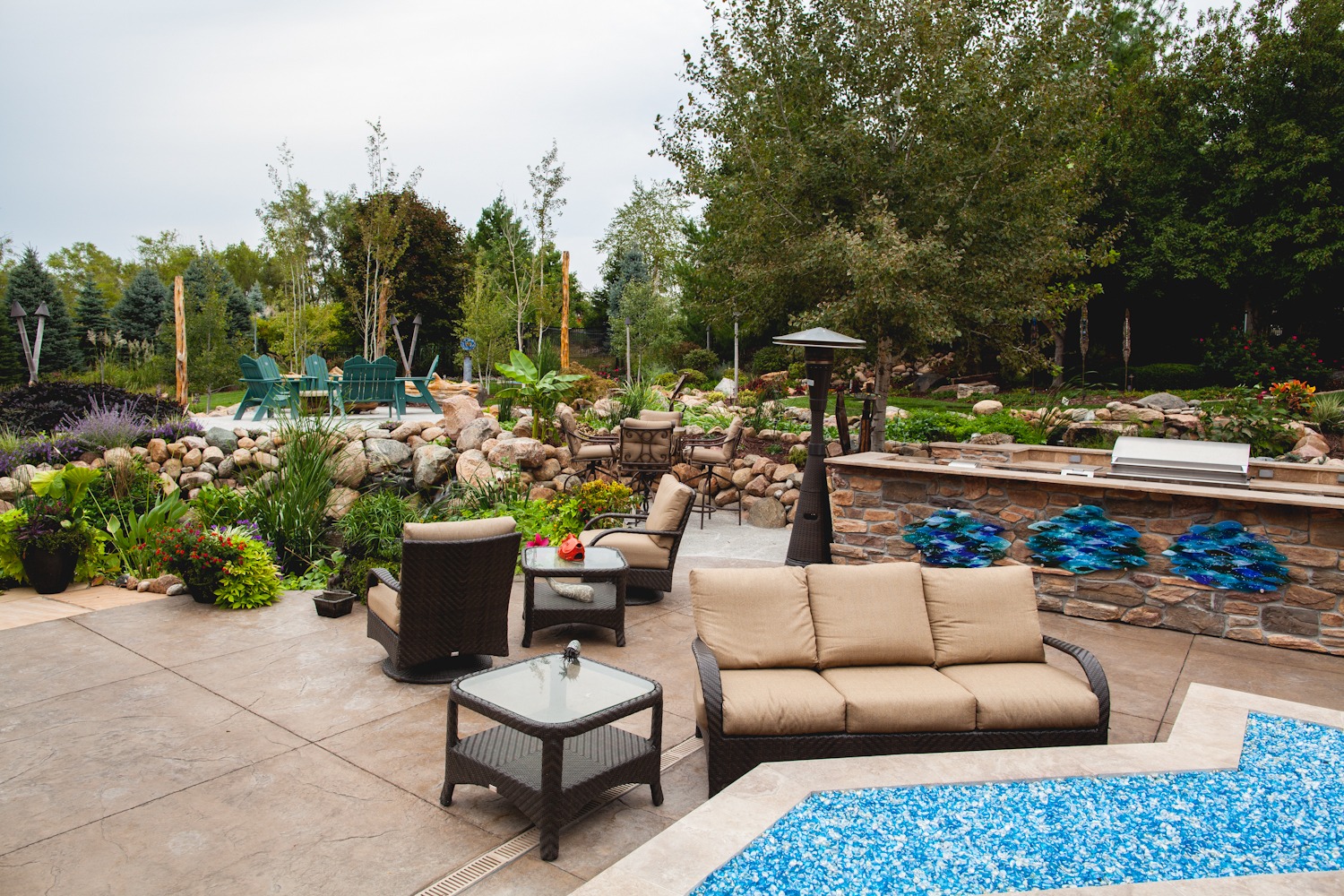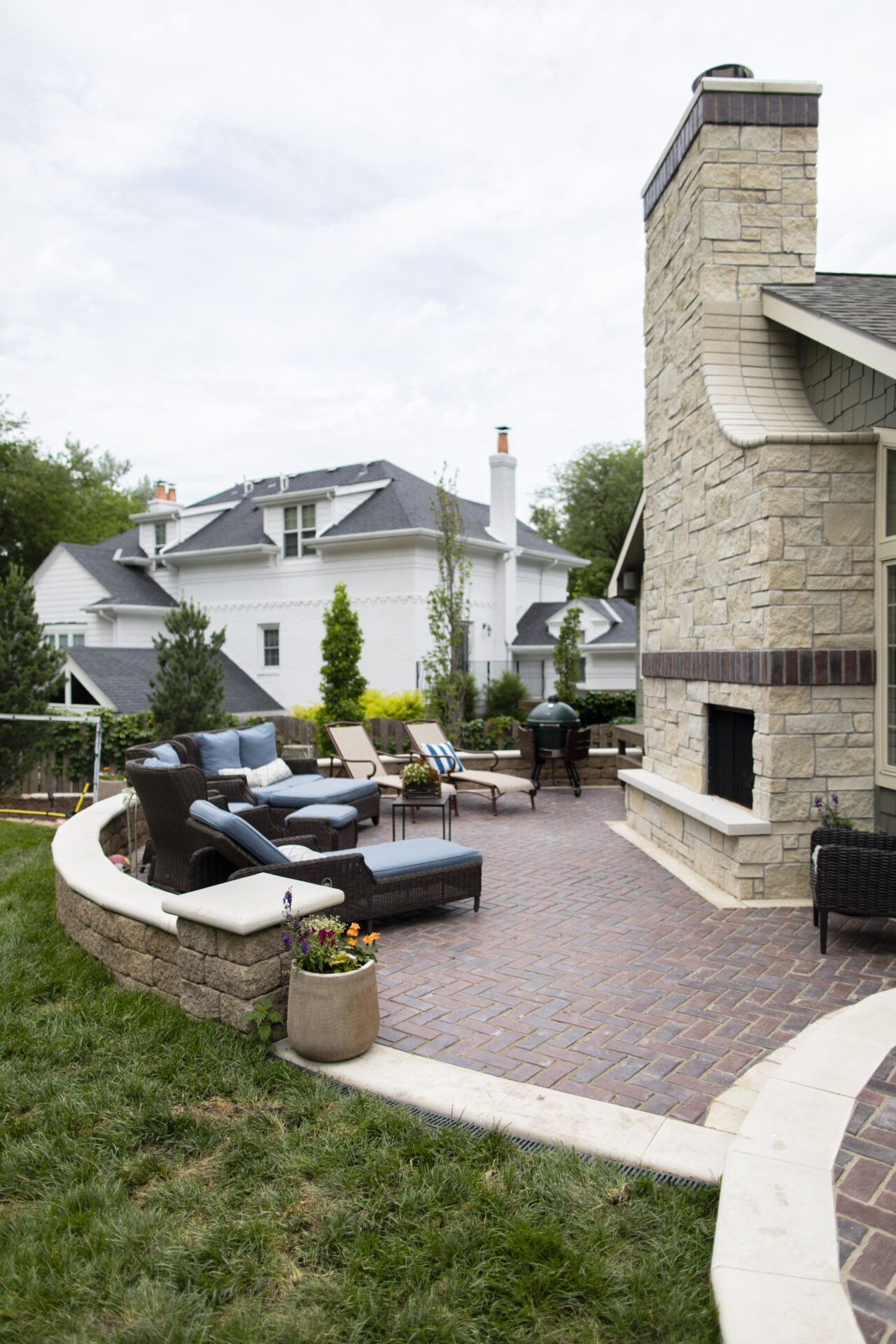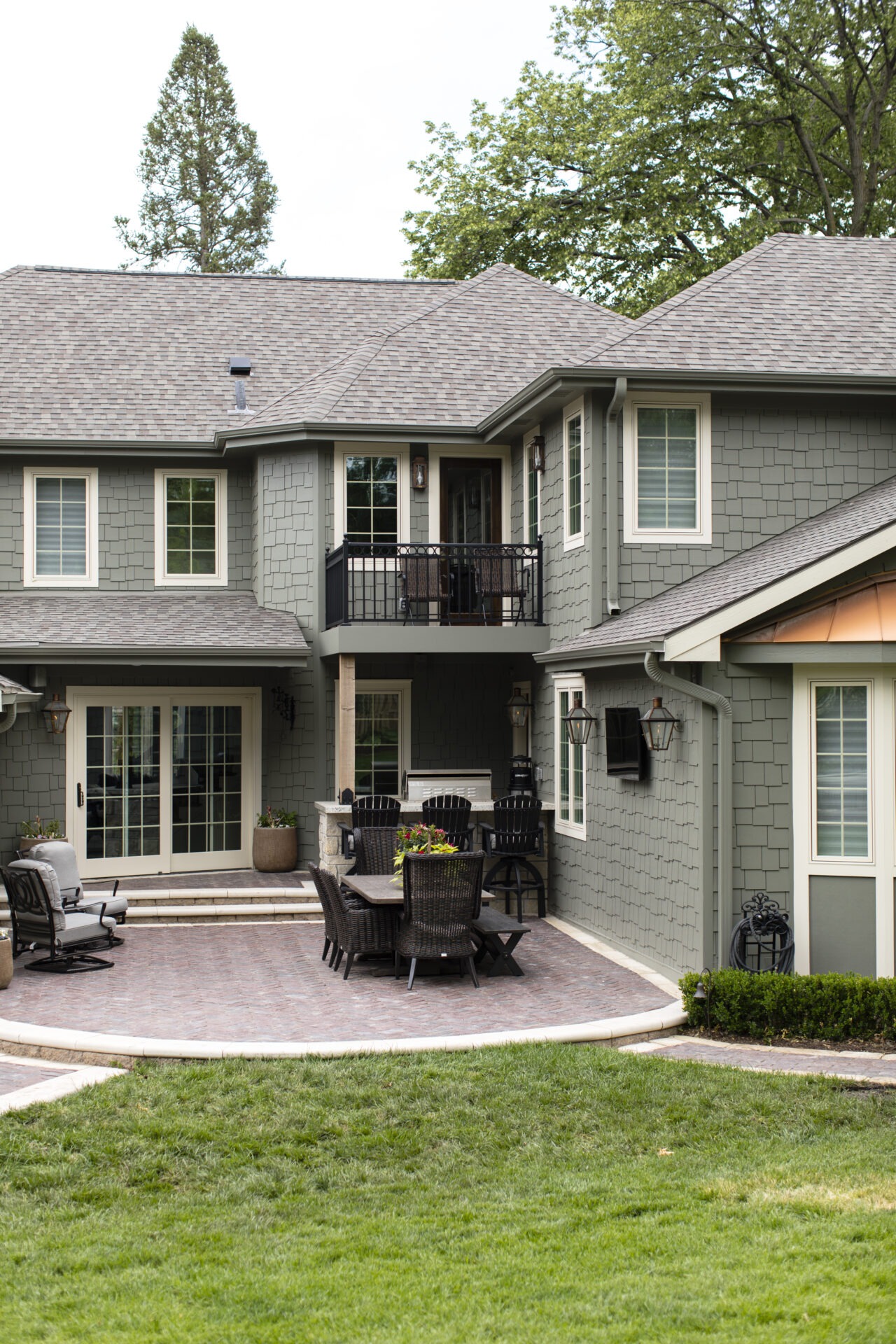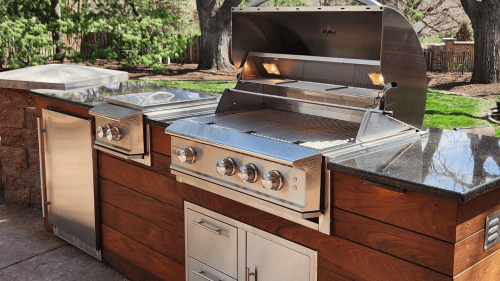Making Amazing Outdoor Kitchens

An ideal outdoor kitchen offers sizzling grills, ample counter space, and lively gatherings. However, unpredictable weather, usability issues, and high maintenance can turn this dream into a hassle. Smart design and quality landscaping provide the solution, creating a backyard oasis that enhances lifestyle and property value. This blog will explore how outdoor kitchens transform homes, particularly in Omaha, and how to perfect yours.
To make the most of your outdoor space, be sure to read our Ultimate Guide to Landscape Design & Build in Omaha.
Essential Elements of Exceptional Outdoor Kitchens

What makes an outdoor kitchen truly exceptional? It comes down to including the right features and using materials that can withstand Omaha’s weather. Here are the must-have elements that no great outdoor kitchen should be without:
- Grill (Cooking Station): The grill is the heart of any outdoor kitchen. Whether it’s a built-in gas grill, charcoal smoker, or even a pizza oven, choose a high-quality model that suits your cooking style. This is where you’ll sear steaks, flip burgers, or roast veggies while chatting with guests – so make it count.
- Countertops and Prep Space: Ample counter space is essential for prepping food and serving drinks. Durable countertops like granite, concrete, or natural stone are popular because they handle the elements and are easy to clean. In Omaha’s climate, a weather-resistant stone counter is ideal since it resists moisture damage and can handle seasonal temperature swings.
- Refrigeration and Sink: Having a small outdoor refrigerator keeps beverages cold and ingredients fresh, so you don’t have to run back to the indoor fridge. An outdoor-rated fridge is designed to work in higher temperature ranges and is built for rain and snow protection. A sink with running water is another game-changer – it makes cleaning up and food prep much easier.
- Seating and Dining Area: An outdoor kitchen isn’t complete without a place for people to sit and enjoy the feast. Consider a bar counter with stools built into the kitchen island, a cozy dining table under a pergola, or even an adjacent fire pit area with chairs. Comfortable seating turns your outdoor kitchen into an outdoor dining room.
- Lighting: Cooking and entertaining often continue after sunset, so lighting is critical. Incorporate task lighting like under-counter or grill lights to illuminate cooking surfaces, as well as ambient lighting (string lights, lanterns, or built-in LED landscape lights) to create a warm atmosphere. Good lighting isn’t just about mood – it also extends the usable hours of your kitchen, ensuring safety and convenience at night.
- Shade and Shelter: Omaha summers are hot and sunny, with fast thunderstorms, so plan for shade and weather protection. Options include pergolas, awnings, or patio umbrellas. Pergolas offer partial shade and can be draped with vines or fabric. Pavilions or extended roofs provide more protection, allowing use in drizzly weather. Shade structures keep guests comfortable and protect kitchen surfaces from UV damage. For covered outdoor kitchens, consider a grill vent hood for smoke ventilation, ensuring comfort and code compliance.
Landscaping Integration: Elevating Your Outdoor Kitchen Design
An outdoor kitchen isn’t an isolated addition – the best designs blend seamlessly with the landscape. Professional landscaping in Omaha can elevate your outdoor kitchen both functionally and aesthetically, turning the whole backyard into a cohesive outdoor living space. There are a few smart landscaping strategies to consider:
- Privacy Plantings and Wind Protection: Strategic plantings around your outdoor kitchen can make the space more comfortable and intimate. Evergreens or tall shrubs provide privacy and block strong winds, creating a living windbreak. Greenery adds beauty, shade, and a lush ambiance with climbing vines.
- Hardscapes (Patios, Pathways, and Walls): Well-planned hardscape features are the backbone of an integrated outdoor kitchen design. A sturdy patio is the foundation, creating a level surface for your kitchen and seating. Pathways connect the kitchen to the house, ensuring flow. Retaining walls define zones, provide seating, and manage elevation changes. Thoughtful hardscaping ensures your outdoor kitchen feels like an extension of your home.
- Fire and Water Features for Ambiance: Complementary features boost the atmosphere. Fire pits or outdoor fireplaces create cozy gathering spots and can act as windbreaks. Water features like fountains introduce soothing soundscapes and visual focal points. These features create a full sensory experience and contribute to property value.
By weaving together plantings, hardscapes, and special features, your outdoor kitchen will feel organically part of your yard. Thoughtful landscaping in Omaha ensures your space is ready for local conditions, using native plants and proper drainage. This level of planning pays off financially, significantly increasing curb appeal and home value.
Planning Your Omaha Outdoor Kitchen: Key Steps

Ready to bring your outdoor kitchen dreams to life? Careful planning is key. Here is a step-by-step guide for Omaha homeowners to plan a successful outdoor kitchen project:
- Define Your Goals and Vision: Think about how you’ll use your outdoor kitchen (family BBQs, parties, quiet dinners) and your cooking style (grilling, smoking, pizza). This guides every decision, from appliances (gourmet grill vs. spacious bar) to atmosphere (casual vs. modern). Jot down your “wish list” to refine later based on budget and space.
- Set a Realistic Budget: Outdoor kitchens range from simple to elaborate. Research local Omaha costs; modest setups start in the low five figures, luxury projects climb higher. Include construction, appliances, lighting, and furniture in your budget, plus a contingency. Get early cost estimates for wish list items. Aim for the best quality you can afford on key features.
- Choose Durable Materials for Omaha’s Climate: Omaha’s extreme weather demands durable materials. Opt for weather-proof, Omaha-tested options: stainless steel appliances (rust/corrosion resistant), stone/concrete counters (crack/moisture resistant), and pressure-treated/composite wood (rot/warping resistant). Always use outdoor-rated appliances. Properly seal masonry to prevent freeze-thaw damage. Plan for sturdy, wind-resistant overhead covers.
- Hire the Right Contractor or Designer: For most projects, hire an experienced landscape designer or contractor in Omaha. A local expert understands permits and climate considerations (e.g., gas line depth for frost). Ask for past project photos and references. Get multiple quotes and design ideas, weighing experience, creativity, and reputation over just cost. The right contractor refines design, handles technical details, and coordinates other trades. Discuss goals, budget, and HOA rules upfront.
- Check Permits and Approvals: Most outdoor kitchens in Omaha require permits, especially for new gas lines, plumbing, or roof structures. Your contractor can help, but it’s the homeowner’s responsibility. Skipping permits can lead to fines. If you have an HOA, get written approval as they may have rules on permanent outdoor structures. Check local building codes for restrictions (e.g., clearance distances). Handle permits early for peace of mind.
Maintenance Tips for Your Outdoor Kitchen in Omaha
Once your outdoor kitchen is built, you’ll want to keep it in top shape. Regular upkeep will protect your investment and ensure it remains a beloved feature. Here are some easy, actionable maintenance tips for Omaha’s climate:
- Winter Protection: Omaha winters are harsh. Drain and shut off water lines (sinks, ice makers) to prevent freezing. Unplug outdoor refrigerators and ice makers. Clean and dry all appliances, then cover them with high-quality, breathable covers. Covering the entire island is ideal to prevent freeze-thaw damage. Store sensitive components (like propane tanks) indoors if possible. These steps ensure your kitchen is ready for spring.
- Routine Cleaning and Care: Like an indoor kitchen, your outdoor kitchen needs regular cleaning. After each use, or routinely, clean grill grates and wipe counters to prevent wear and pests. Use mild soap and water for surfaces and stainless steel, applying stainless cleaner or light oil to prevent rust. Empty and clean drip trays, and safely dispose of charcoal ashes. Annually check stone countertops for re-sealing. Inspect and replace lighting bulbs for safety. Regular cleaning keeps your kitchen inviting.
- Landscaping Upkeep: The surrounding landscape impacts your outdoor kitchen’s longevity. Trim encroaching branches and clear leaves from the patio to prevent stains and mildew. Ensure drainage areas are clear. Refresh mulch. In winter, use a plastic shovel on pavers and pet-safe ice melt on paths to prevent damage and slips. Caring for the landscaping maintains beauty and functionality, protecting your property’s value.
Common Mistakes to Avoid in Outdoor Kitchen Projects

Even the best intentions can go awry if you’re not careful. Here are some common mistakes Omaha homeowners should avoid when creating an outdoor kitchen, and how to sidestep them:
- Poor Site Selection or Layout: Placing your outdoor kitchen in the wrong spot can really dampen its utility. Avoid setting up too far from the house or too close without proper ventilation. Aim for a convenient location with open air. A common pitfall is cramping the space; ensure adequate countertop space for prep and serving, and enough clearance for movement. Think in terms of “zones” (cooking, prep, dining) and ensure each has elbow room.
- Ignoring Drainage and Landscaping Needs: Improper drainage can lead to water pooling and damage. Ensure your patio is graded to drain water away and incorporate drains if needed. Not integrating the kitchen with your landscaping is a missed opportunity. Plan landscaping concurrently: add perimeter plantings or flower beds to soften hard edges, and consider foot traffic flow. Account for snow removal in winter.
- Using the Wrong Materials for Omaha’s Climate: Choosing materials that can’t handle Nebraska’s weather extremes is a recipe for regret. Always use materials rated for outdoor use and suitable for our climate, such as pressure-treated or composite wood, galvanized or stainless fasteners and stone or concrete surfaces. Don’t forget exterior-grade electrical outlets (with GFCI protection) and outdoor-safe plumbing.
- Inadequate Lighting and Shade: These are essential to comfort and utility. A common mistake is not installing enough lighting; plan for layers of light: task and ambient. Neglecting shade or weather cover can limit usability. Include a shade solution like a pergola or umbrella, and consider a fallback like a removable canopy for hail or heavy rain.
Outdoor Kitchen Projects Made Easy
An outdoor kitchen isn’t just an addition to your home; it’s a lifestyle upgrade. It dramatically expands your usable living and entertaining space, allowing for more enjoyable gatherings and family time outdoors. Designed to adapt seamlessly to Omaha’s diverse climate, these kitchens can be enjoyed almost year-round. Beyond the immediate benefits, an outdoor kitchen is a significant investment that boosts your home’s value and appeal.
Sun Valley Landscaping specializes in designing and building custom outdoor kitchens that families will cherish and utilize for years to come. Every project is backed by extended warranties—including a 5-year warranty beyond manufacturer coverage—so you can enjoy peace of mind long after installation.
Contact us today to schedule a personalized consultation and start planning your dream outdoor culinary space, and find out just how much your landscaping increases home value in Omaha.
Tags:

